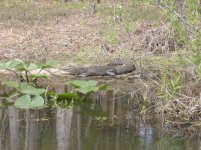I have a 5.5 hp Johnson CD-21 motor from 1964 and managed to have my first ever shear pin failure. I could use some infomation from some veterans who have experienced more than a few. I think it failed from fatigue during a shift rather than hitting a rock since I was having trouble with the idle and was trying to shift at a higher than normal rpm. Also I don't think I was in shallow enough water to hit something. I think the shear pin had been previously replaced with one that didn't match the original specs. The failed pin was 5/32 dia and I can easily fit a 3/16 drill bit through the drive shaft and hub. Do you agree that a 3/16 pin should be used to replace it? Having a smaller dia would create more clearance between the parts which would allow a harder hit on the pin as it accellerates through that clearance with both the prop shaft and the propeller hub and the smaller dia would also likely have a smaller shear force unless there was a material difference. The other puzzling thing was that the three pieces of the failed pin had a total length greater than the o.d. of the propeller hub at the drive hole. The rubber cone would still hold it in place though it would have to be forced over the ends of the pin, but I don't think the pin length should ever exceed the o.d. of the propeller drive hub, should it? Lastly, does anyone have a CD-21 and a spare shear pin or an old parts manual so they could tell me the dimensions of the correct shear pin or perhaps an OEM part number. Thanks for any help.
Home
Outboard Motor Parts
Chrysler outboard parts Evinrude outboard parts Force outboard parts Honda outboard parts Johnson outboard parts Mariner outboard parts Mercury outboard parts Suzuki outboard parts Tohatsu outboard parts Yamaha outboard partsInboard & Sterndrive Engine Parts
Chrysler Marine inboard parts Crusader Marine parts MerCruiser sterndrive parts OMC sterndrive parts Pleasurecraft Marine parts Volvo Penta marine parts + MoreAll Engine Brands
All Manuals HomeOutboard Repair Manuals
Chrysler outboard manuals Evinrude outboard manuals Force outboard manuals Honda outboard manuals Johnson outboard manuals Mariner outboard manualsMercury outboard manuals Nissan outboard manuals Suzuki outboard manuals Tohatsu outboard manuals Yamaha outboard manuals
Inboard & Sterndrive Engine Manuals
MerCruiser sterndrive manuals OMC sterndrive manuals Volvo Penta marine engine manualsPlease Note
MarineEngine.com does not offer troubleshooting assistance or repair advice by email or by telephone.
You are invited to join our public Boat Repair Forum to seek assistance from other members.
You may also visit the Boat Motor Manuals section of our site to obtain a service manual.


